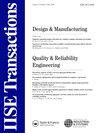3D打印中自由形状产品精度鉴定的自动偏差感知地标选择
IF 2
3区 工程技术
Q3 ENGINEERING, INDUSTRIAL
引用次数: 0
摘要
摘要在非刚性形状配准中,标志是识别设计与实际产品对应关系的关键。在3D打印中,由于复杂的产品几何形状及其不均匀的形状偏差,手动选择地标成为劳动密集型。然而,自动选择必须精确定位容易偏离精度的几何区域的标志。现有的自动地标标记方法往往会对高曲率的显著特征产生聚类和冗余的地标,从而影响全局和局部配准误差的平衡。为了解决这些问题,我们提出了一种基于偏差感知分割和标记的自动地标选择方法。与用于语义特征识别的分割不同,偏差感知分割是用于高曲率区域识别的自由曲面产品。这些区域容易产生偏差,通过曲率敏感重网格提取高曲率的顶点,并根据顶点密度自动聚类。在每个分段或高曲率区域内,为高斯过程地标定制曲率加权函数,依次选择具有最高局部曲率的地标。此外,我们还提出了一种新的评价标准,通过注册来评价所选地标的有效性。通过打印牙模型的自动标记对该方法进行了验证。关键词:3D打印资格;非刚性形状配准;形状分割;聚类;高斯过程里程碑免责声明作为对作者和研究人员的服务,我们提供此版本的接受稿件(AM)。在最终出版版本记录(VoR)之前,将对该手稿进行编辑、排版和审查。在制作和印前,可能会发现可能影响内容的错误,所有适用于期刊的法律免责声明也与这些版本有关。林伟志,洛杉矶南加州大学Daniel J. Epstein工业与系统工程系的一名博士生。她于2019年在北京航空航天大学获得统计学学士学位。她的研究重点是利用领域知识开发模型来分析复杂的流形数据,特别强调解决先进制造领域的挑战。羌族HuangDr。黄强,美国南加州大学洛杉矶分校Daniel J. Epstein工业与系统工程系教授。主要研究方向为智能制造的机器学习和个性化制造的质量控制。2012年至2016年,他是南加州大学工程学院Gordon S. Marshall早期职业主席。他获得了IISE Fellow奖,ASME Fellow奖,NSF CAREER奖,2021年IEEE案例最佳会议论文奖,2013年IEEE自动化科学与工程交易最佳论文奖等。他拥有增材制造质量控制方面的五项专利。他曾担任IISE Transactions的部门编辑,ASME Transactions的副编辑,Journal of Manufacturing Science and Engineering。本文章由计算机程序翻译,如有差异,请以英文原文为准。
Automated Deviation-Aware Landmark Selection for Freeform Product Accuracy Qualification in 3D Printing
AbstractLandmarks are essential in non-rigid shape registration for identifying the correspondence between designs and actual products. In 3D printing, manual selection of landmarks becomes labor-intensive due to complex product geometries and their non-uniform shape deviations. Automatic selection, however, has to pinpoint landmarks indicative of geometric regions prone to deviations for accuracy qualification. Existing automatic landmarking methods often generate clustered and redundant landmarks for prominent features with high curvatures, compromising the balance between global and local registration errors. To address these issues, we propose an automatic landmark selection method through deviation-aware segmentation and landmarking. As opposed to segmentation for semantic feature identification, deviation-aware segmentation partitions a freeform product for high-curvature region identification. Prone to deviation, these regions are generated through curvature-sensitive remeshing to extract vertices of high curvature and automatic clustering of vertices based on vertex density. Within each segment or high-curvature region, a curvature-weighted function is tailored for the Gaussian process landmarking to sequentially select landmarks with the highest local curvatures. Furthermore, we propose a new evaluation criterion to assess the effectiveness of selected landmarks through registration. The proposed approach is tested through automatic landmarking of printed dental models.Keywords: 3D printing qualificationnon-rigid shape registrationshape segmentationclusteringGaussian process landmarkingDisclaimerAs a service to authors and researchers we are providing this version of an accepted manuscript (AM). Copyediting, typesetting, and review of the resulting proofs will be undertaken on this manuscript before final publication of the Version of Record (VoR). During production and pre-press, errors may be discovered which could affect the content, and all legal disclaimers that apply to the journal relate to these versions also. Additional informationNotes on contributorsWeizhi LinWeizhi Lin is a PhD student in the Daniel J. Epstein Department of Industrial and Systems Engineering at the University of Southern California (USC) in Los Angeles. She completed her B.E. degree in Statistics at Beihang University in 2019. Her research focuses on leveraging domain knowledge to develop models for analyzing complex manifold data, with a specific emphasis on addressing challenges in the field of advanced manufacturing.Qiang HuangDr. Qiang Huang is a professor at the Daniel J. Epstein Department of Industrial and Systems Engineering, University of Southern California (USC), Los Angeles. His research focuses on Machine Learning for Smart Manufacturing and Quality Control for Personalized Manufacturing. He was the holder of the Gordon S. Marshall Early Career Chair in Engineering at USC from 2012 to 2016. He received the IISE Fellow Award, ASME Fellow Award, NSF CAREER Award, 2021 IEEE CASE Best Conference Paper Award, and 2013 IEEE Transactions on Automation Science and Engineering Best Paper Award, among others. He holds five patents on quality control for additive manufacturing. He was a Department Editor for IISE Transactions and an Associate Editor for ASME Transactions, Journal of Manufacturing Science and Engineering.
求助全文
通过发布文献求助,成功后即可免费获取论文全文。
去求助
来源期刊

IISE Transactions
Engineering-Industrial and Manufacturing Engineering
CiteScore
5.70
自引率
7.70%
发文量
93
期刊介绍:
IISE Transactions is currently abstracted/indexed in the following services: CSA/ASCE Civil Engineering Abstracts; CSA-Computer & Information Systems Abstracts; CSA-Corrosion Abstracts; CSA-Electronics & Communications Abstracts; CSA-Engineered Materials Abstracts; CSA-Materials Research Database with METADEX; CSA-Mechanical & Transportation Engineering Abstracts; CSA-Solid State & Superconductivity Abstracts; INSPEC Information Services and Science Citation Index.
Institute of Industrial and Systems Engineers and our publisher Taylor & Francis make every effort to ensure the accuracy of all the information (the "Content") contained in our publications. However, Institute of Industrial and Systems Engineers and our publisher Taylor & Francis, our agents, and our licensors make no representations or warranties whatsoever as to the accuracy, completeness, or suitability for any purpose of the Content. Any opinions and views expressed in this publication are the opinions and views of the authors, and are not the views of or endorsed by Institute of Industrial and Systems Engineers and our publisher Taylor & Francis. The accuracy of the Content should not be relied upon and should be independently verified with primary sources of information. Institute of Industrial and Systems Engineers and our publisher Taylor & Francis shall not be liable for any losses, actions, claims, proceedings, demands, costs, expenses, damages, and other liabilities whatsoever or howsoever caused arising directly or indirectly in connection with, in relation to, or arising out of the use of the Content. Terms & Conditions of access and use can be found at http://www.tandfonline.com/page/terms-and-conditions .
 求助内容:
求助内容: 应助结果提醒方式:
应助结果提醒方式:


